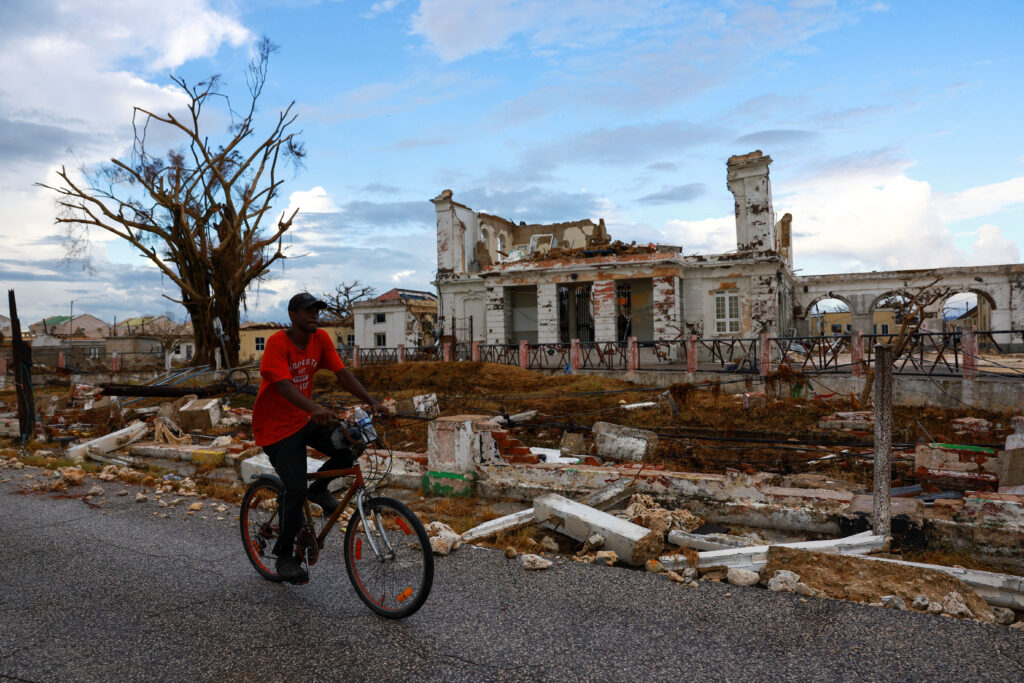By any standard, Jamaica has been a model of fiscal discipline and climate preparedness. For more than a decade, it kept a primary surplus above 3 percent of gross domestic product (GDP), reduced its debt, and earned bipartisan praise for responsible governance. In September, S&P Global Ratings upgraded Jamaica’s credit rating to BB- and reaffirmed its “positive outlook,” a rare achievement for any small island economy.
Then came Hurricane Melissa, the strongest Atlantic hurricane on record ever to make landfall in Jamaica. Starting late last month and into this week, it tore through the island’s central and western parishes, destroying towns, roads, hospitals, and critical infrastructure.
After days of watching the slow, relentless approach of Hurricane Melissa, one of the authors, Patricia, sheltered in her home in Kingston. She could hear the wind howling at over 100 miles per hour (mph) and rain lashing sideways against the windows—yet even that was nothing compared to the 185 mph winds and torrential rain battering the west of the country, where her friends and family live. While Patricia dealt with small leaks, her friends and family were left with nothing.
In the days after, her family visited some of the hardest-hit communities to distribute care packages, and what they saw was heartbreaking. Entire neighborhoods flattened, the landscape looking as if an atomic blast had torn through it.
At least 40 percent of the buildings and roads on the western part of the island, including Montego Bay, suffered damage. Many small communities, such as the port town Black River, were almost completely wiped out. Such damage is remarkable mostly for its sudden severity, not for its novelty. The Caribbean Community (CARICOM) countries lose an estimated 2 percent of their infrastructure capital stock annually to climate-related damage. Infrastructure upgrades must therefore be a priority, given the region’s exposure to natural disasters and climate change.
This is where US leadership can step in, not as charity, but as shared investment in resilience and regional stability. Jamaica has kept its promises: it has delivered disciplined fiscal reform, climate-smart policies, and innovation in risk financing. It has done what the international system asks of developing nations. Now, it needs that system, and its closest ally, the United States, to respond.
Reality over foresight
The Caribbean remains highly vulnerable to hurricanes and other climate-related events, which can disrupt or extend projects critical to rebuilding, driving up costs. Natural disasters often destroy essential infrastructure, forcing projects to pause or cancel. The question now is how long it will take Jamaica to recover from this cumulative destruction. The immediate response is urgent, but so too is planning for the months ahead. With projections indicating that dangerous climate events will become more frequent and severe, insurability declines and the cost of future investment rises.
The damage caused by Hurricane Melissa already amounts to almost eight billion US dollars, which is equivalent to nearly half of Jamaica’s annual GDP. That figure dwarfs the country’s much-heralded $150 million parametric catastrophe bond that it arranged with the World Bank. This bond, purchased as a form of insurance from capital markets, is designed to trigger after major disasters like this one. Given the strength of Hurricane Melissa and the scale of Jamaica’s losses, it is expected that the 2024 catastrophe bond to pay out its full $150 million value. Even so, Jamaica will need much more to rebuild.
Two sustainable paths forward
The destruction caused by Hurricane Melissa is so extensive that once the search-and-rescue efforts end and basic services such as water and electricity are restored, the damage to homes and infrastructure will exceed the capacity of any single government. Jamaica’s recovery will likely therefore depend on two important factors: innovative financing models that reduce investment risk and strong public-private partnerships that accelerate sustainable recovery.
The Caribbean’s unique and small markets call for creative financing, but there are tools readily available to help US companies invest in infrastructure and the recovery process. Two options are especially relevant.
First, US companies partnering with multilateral development banks and insurance companies can help de-risk investments. To reach the average of advanced economies by 2030, Jamaica would need significant investment, including $5.8 billion for new infrastructure and asset replacement in road infrastructure. It would also need more than $1.4 billion toward telecommunications infrastructure for fixed broadband and 4G networks to reach equivalent levels in developed economies. This significant need offers opportunities large enough to attract major investment. Limited human and institutional capacity make collaboration with third-party institutions even more important. Projects such as the Inter-American Development Bank’s One Caribbean program can help prepare projects, strengthen public-private partnerships, and manage political risk. Equally important is building trust with local partners. Many Caribbean firms are family-owned and community-rooted, which makes relationship-building essential for lasting investment. Joining local business organizations such as American Chamber of Commerce chapters and participating in trade missions can help US investors understand regulations, identify talent, and ensure that projects succeed over time.
Second, public-private partnerships can help the Jamaican government and their partners meet urgent recovery needs while driving long-term, sustainable efforts. Launching public-private partnerships is one of the most effective ways to mobilize capital from local, regional, and private investors. Under these partnerships, governments provide needed guarantees and subsidies to reduce risk, while the private sector generates the capital needed to determine a project’s commercial viability.
It is important that this model is used, as opposed to wholesale private ownership of foreign operators, to avoid eroding projects’ national economic value. Therefore, local equity participation should be prioritized in public-private partnership structures to maximize national benefits and ensure long-term sustainability. The private sector can work with governments and local civil society to strengthen resilience through environmental and social impact assessments. It can also support by improving infrastructure standards, including for underground piping and the usage of hurricane-proof glass, as well as updating building codes where necessary. Insurance can also help keep infrastructure projects afloat during delays and stoppages resulting from natural disasters. At the same time, new investments will need to focus on renewable energy, resilient infrastructure, digital connectivity, and community housing, all sectors where US expertise and capital can make an immediate impact.
Hurricane Melissa tested Jamaica’s strength and found it unbreakable but not inexhaustible. The island has proven that fiscal responsibility is possible. Now it’s time for the United States to prove that climate solidarity is, too.
Patricia R. Francis, who currently resides in Jamaica, is a nonresident senior fellow for the Caribbean Initiative at the Adrienne Arsht Latin America Center, Atlantic Council.
Maite Gonzalez Latorre is a program assistant at the Adrienne Arsht Latin America Center, Atlantic Council.
Further reading
Tue, Mar 25, 2025
The US needs to build a new Caribbean policy. Rubio’s trip to the region can be the first step.
New Atlanticist By Wazim Mowla
US engagement with the Caribbean should prioritize energy investments and efforts to reduce violent crime in the region.
Wed, Jul 3, 2024
Hurricane Beryl spotlights the importance of climate adaptation in the Caribbean
New Atlanticist By Wazim Mowla
The earliest category five Atlantic hurricane on record is a reminder that governments and the private sector must prioritize adapting to climate change. COP29 is a good place to start.
Mon, Apr 29, 2024
Climate change doesn’t have to result in greater gender inequity in the Caribbean
New Atlanticist By Wazim Mowla
Caribbean climate policy design and resource allocation must incorporate the voices and interests of the region’s women and girls.
Image: A man rides a bicycle in front of the damaged St. Elizabeth Parish Court in the aftermath of Hurricane Melissa, in Black River, Jamaica, November 5, 2025. REUTERS/Raquel Cunha.




